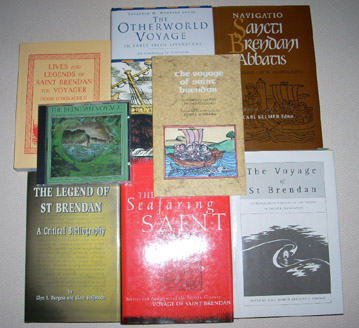A synchronism & bibliography
A synchronism
NOTE : A brief synchronism below indicates interrelationships between the Celtic Church and the Roman Catholic Church only.| Celtic Christianity | Roman Catholic Christianity | Major events in Japan |
|---|---|---|
| AD371 Monastacism brought from Alexandria through the Lerins Islands and Tours, now in France.
c.397 Saint Ninian established his monastery called 'Candida Casa', in Whithorn, Galloway, along the southwestern coast of Scotland, which turned out many of the Irish monks. 401 Patrick, sold as a slave to a clan in Ireland ; seven years later, he managed to flee from Ireland. 461( traditionally said 432 ) Patrick returned to Ireland, now as a bishop. 490 Enda ( Eanna, Einne or Endeus, ? - c. 530 )established his training centre for young monks in Inishmore, Aran Isles. The Navigator Saint Brendan( 484? - 577 ) ; established a major monastery in Clonfert( 554 ). 530? Saint Finnian( d. c. 549 )established his monastery at Clonard. 545? Saint Ciaran( 512/516 - 545/549 )established his monastery at Clonmacnoise. 558 Saint Comgall( 517-603 )established his monastery at Bangor. Saint Columba( Colm Cille )established his monastery at Derry( 546 ), then Durrow( 556 ). 563 Saint Columba established his community at Iona ( Hy ) 565? Saint Brendan the Navigator, met Columba at Iona. 591 Saint Columbanus( Columbán, 543 ? - 615 )left for the Continent and started his mission there. 635 Saint Aidan(?-651), the Apostle of Northumbria, established a Celtic monastery at Lindisfarne, now Holy Island. 650 - 700 The Book of Durrow 650-750 High Crosses of stone flourished. 698? - The Lindisfarne Gospels ; its creation attributed to Eadfrith of Lindisfarne, and the binding to Billfrith. 750-800 Creation of The Book of Kells, in commemoration of Saint Columba. before 780 Architypal Vita Sancti Brendani created ? 780-800 Architypal Navigatio Sancti Brendani created ? eigth - ninth centuries So called Céli Dé ; creation of The Stowe Missal. 793-95 attacks by the Norsemen ; the Lindisfarne Community marauded. ( 793 ) 837 Great fleets of Norsemen's longships, appeared on both River Liffey and Lough Bo Finne. 840 Armagh( Ard Mhacha )assaulted by Norsemen. 1169 Invasion of the Normans 1188 Giraldi Cambrensis, Topographia hibernica |
AD313 Constantine I declared the Edict of Milan, agreed the Trinity doctorin by Athanasius of Alexandria as the Official Catholic Church. 325 First Council of Nicaea adopted the Original Nicene Creed, condemned the so-called Arianism. 375-410 The Great Barbarian Invasion, began as the Visigoth invasion to Rome. Saint John Cassian( 360-435 ) 476 The fall of the Western Roman Empire Flavius Magnus Aurelius Cassiodorus Senator (490?-585?). 539 Rule of Saint Benedict ordered by Saint Benedict of Nursia (480-547) ; henceforce the Canon was universally adopted by the western monasteries. 597 Pope Gregory the Great, sent Augustine of Canterbury to Kingdom of Kent. 601 Augustine, consecrated as the first archbishop of Canterbury 605-664 The so-called Easter Controversy ; Synod of Whitby decided to observe the monastic tonsure and calculate Easter in the Roman custom. 610 Saint Columbanus expelled from Gaul. 612 Saint Columnbanus arraived in Kingdom of the Lombards ; established his monastery at Bobbio, where he died in 615. The Venerable Bede( 672/3 - 735 ), and his The Ecclesiastical History of the English People completed in c.731. 697 The Church of Ireland officially accepted the Roman liturgical calendar at the Synod of Barr except for the Iona monastery, supporting the traditional Celtic calendar( - 712 ). 800 Charlemagne, crowned as the first emperor of the rivived Roman Empire, and his 'Carolingian Renaissance'. A renowned Irish theologian / Neoplatonist philosopher / poet Johannes Scotus Eriugena( 810 - 877? ), his De divisione naturae ( 862-66 ) 825 De mensura Orbis terrae by Dicuil, an Irish monk and geographer at the Frankish court. c.890 Alfred the Great of the Kingdom of Wessex( r 871〜899 ) ; compiled Anglo-Saxon Chronicle ( 〜1154 ). 911 Duchy of Normandy established. 962 Otto the Great, the founder of the Holy Roman Empire, coronated. 1054 The Great Schism( East-West Schism ) 1066 The Norman Conquest 1096-99 The First Crusade organised. |
c.AD350 Yamato Dynasty established.
538 Buddhism introduced to Japan by the Baekje people. 592 Empress Suiko enthroned. 604 Prince Shotoku announced his Seventeen-Article Constitution 607 Horyu-ji temple founded. 645 The Taika Reforms 667 Capital transferred to Oumi-no-niya. 694 Capital transferred to Fujiwara-kyo. c.694 - 710 Takamatsuzuka Tomb, Kitora Tomb constraucted. 710 Capital transferred to Heijo-kyo. 712 Kojiki compiled. 720 The Chronicles of Japan compiled. 752 Toudai-ji temple founded ; the eye-opening ceremony on the completion of the Great Buddha statue held. 758 - 97 Shoku Nihongi compiled ; the oldest record on eruptions of Mt Fuji. 794 Capital transferred to Heian-kyo. 816 Kukai a.k.a. Kobou-Daishi founded his temple called Kongobu-ji on Mt Kouya. 841 Nihon Kouki compiled. 864-66 The so-called Jougan eruption of Mt Fuji ; forming the Lakes of Motosu, Shouji and Sai around the foot of the volcano. 894 The last embarkment of the Japanese missions to Tang China. 901 Sugawara no Michizane relegated to Dazai-fu, the regional government in Kyushu Isle. 905 Collection of Poems of Ancient and Modern Times published. 935-41 'War in the Tengyo era' ; c.935 The Tosa Nikki, written by the tenth-century Japanese poet Ki no Tsurayuki. 937 Nihongiryaku、recording Mt Fuji's eruption occured in Johei 7. c.1001-1016 The Pillow Book by Sei Shonagon ; The Tale of Genji by Murasaki Shikibu. 1059 The Sarashina Diary by Takasue's Daughter 1083 Mt Fuji erupted. c.1131 The Great Mirror compiled. 1156 The Hogen Rebellion. 1159 The Heiji Rebellion ; exiled to a spot called Hirugashima, Izu Peninsula. 1185 Battle of Dan-no-ura ; Emperor Antoku drowned at Inland Sea, the ruin of the Taira clan. 1190 Saigyo Houshi died. (1118-) 1192 Minamoto no Yoritomo founded his the Kamakura Shogunate, becoming the first Shogun of it. 1205 New Collection of Poems Ancient and Modern compiled. 1212 An Account of a Ten-Foot-Square Hut by Kamo-no-Choumei. 1214 Shinran, a apanese Buddhist monk went to the Eastern Regions of Japan and started his mission there. |
W.W.W. Brendan Links
T he Latin Navigatio Sancti Brendani Abbatis has been keeping 'inspiring' not only explorers like Christopher Columbus or Tim Severin, but also many many artists : say, J.R.R.Tolkien CBE, most renowned English author for his The Lord of the Rings, wrote a verse based upon Latin Navigatio in c.1937, and Matthew Arnold created a poem called Saint Brandan in 1860( in The Poems of Matthew Arnold, Longmans, London, 1965, pp. 463-66 ). In America, a film called The Life, Love and Death of Saint Brendan: a Movie was made in 1946, and then an Irish composer composed a suite inspired by Tim Severin's epic Brendan Voyage in 1980 ; more recently, an American musician Jeff Johnson released his album Prayers of Saint Brendan / Journey Home in 1998 ; A famous Irish band Iona has a repertoire including a song on Saint Brendan, and also a harp-guitarist John Doan composed his version based on Saint Brendan's voyage. An Italian painter Daniel De' Angeli, inspired by the English translation by J.J. O'Meara of Navigatio, created a series of his water paintings and held an exhibition tour around Europe in 1993 ; later his wonderful paintings conbined with English traslation by professor O'Meara, were published in a large format illustrated book. Speaking on picture books, you may include a story on Saint Brendan by an American female writer Jean Fritz. Other samples for kids ; Turas a Bhreandain Thus the Latin Navigatio has been keeping inspiring us in the present age, and then creating our spin-offs in various fashions one after another, for our coevals. In short, it is autely felt that the Latin Navigatio, beyond its Christian theme and timbre throughout, renders some universal themes to all mankind, such as an inward quest. Wikipedia's article on Clonfert Cathedral. The Four Courts Press, a major publishing house in Dublin, has been putting out many of books of vast ranges on Irish mediæval history. A modern French traslation of The Life of Saint Malo. in Utrecht University's official site. An article on how the Irish monasticism developed through the Middle Ages. Links on Saint Brendan over the vast sea of World Wide Web. Dingle Peninsula Tourism's site. National Tourism Development Authority of Ireland official site. An attempt of modern Italian translation of Navigatio, based on MS. Alençon. An epic voyage project by Causeway Coast Maritime Heritage Group, Scotland, in commemoration of 1400th anniversary of Saint Columba( Colmcille )'s death in 1997 ; crew of fourteen men/women embarked for Iona, retracing the Saint's journey to the Isle. The project still continues, such as Navigating Peace 2003, and Isle of Cumbrae Voyage 2010. Heritage Ireland's Ardfert Cathedral. Web page examining ancient ruling clans and their territories in the Munster region. Recently I found such clip on YouTube site : another spin-off, if you would like ; Vita Sancti Colombani by his successor Jonas of Bobbio, in Fordham University Center for Medieval Studies.
Further Reading
Miscellanea : Donncha Ó'Corráin, ‘Studies in West Munster History’, Jounal of the Kerry Archaelogical and Historical Society, 1, 1968-70. James Hornell, ‘The Curraghs of Ireland’, Mariner's Mirror, 23, 1937. An extensive consideration on skin boats used widely in Western European countries as well as Irish curraghs ; Tim Severin relied on this paper for building his replica leather boat Brendan. ( New! A part of the article available here [PDF format] ) Paul Johnstone, The Sea-craft of Prehistory ; prepared for publication by Sea'n McGrail, Harvard University Press, Cambridge, Massachusetts, 1980. Paul Johnstone, ‘The Bantry Boat’, Antiquity, pp.277-84, V.38, N.152, York, 1964( with plates XLV-XLIX ). On the only example of an ancient Irish curragh with five crew rowing curved on a stone pillar( perhaps the only remnant of a stone cross ) overlooking Bantry Bay, Co.Cork, the author points out this is an invaluable and very important relic, urging further researches down the road. Paul Johnstone, ‘A Medieval Skin Boat’, Antiquity, pp.32-7, V.36, N.141, York, 1962( with plates II-IX ) the author explores a possibility that Irish monasticism might have been borne through his reviewing of the ancient trading route using curraghs between Ireland and the Mediterranean world. Arno Borst, Lebensformen im Mittelalter, Propylaen, Belrin, 1986. Thomas Cahill, How the Irish saved civilization, Doubleday, New York, 1995. Jean Delumeau, History of Paradise: The Garden of Eden in Myth and Tradition, University of Illinois Press, 2000. Setsuko Mori, Religion and Cuture in Ireland : a history of their reception, The Board of Publications The United Church of Christ in Japan, Tokyo, 1991. Ryoko Ito : 1). 'Interrogatives indirectes dans le Voyage de Saint Brendan, Manuscrit A' ; see the full text in PDF here. Malcolm Day, A Treasury of Saints 100 Saints : Their Lives and Times, Quantum Publishing Ltd, London, 2001.
Donald Attwater, Catherine Rachel John, Dictionary of Saints, Penguin(Non-Classics) ; 3rd edition, London, 1996. Paul Johnson, A History of Christianity, Weidenfeld & Nicolson, 1976. Tim Severin, Epic Voyages of History : The Brendan Voyage, Films for the Humanities, FFH 5319, 54 min., 1994. An English explorer Tim Severin's documentary of his epic Brendan Voyage 1976 -77. Mike McGrew, illustrated by Marnie Saenz Litz, Saint Brendan and the voyage before Columbus, Paulist Press, New York?Mahwah, N.J., 2005. John Cherry, et al., Mythical beasts, British Museum Press, 1995, London. Henri Irénée Marrou, Nouvelle Histoire de l'Église, I, Éditions du Seuil, Paris, 1963. Juan Maria Laboa edit., The Historical Atlas of Eastern and Western Christian Monasticism, 2003.
| ||||||||||||||||||||||||||||||||||||||||||||||||



